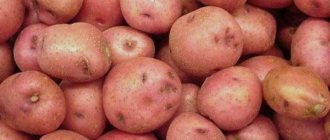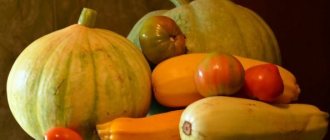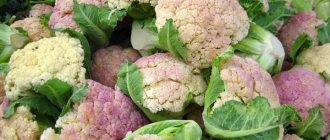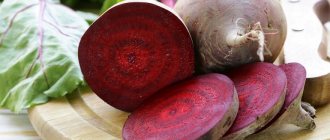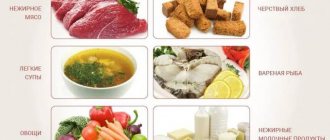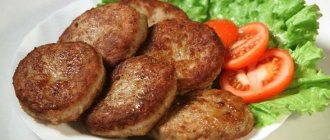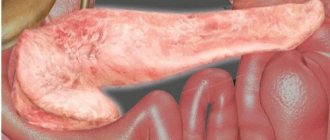Cauliflower is an affordable, very tasty and extremely healthy vegetable. While raw cauliflower may not be everyone's cup of tea, few will be able to resist cauliflower soup or baked cauliflower with cheddar.
Cauliflower gets its name from its delicate inflorescences. It is these flowers – the heads – that are eaten. In Great Britain there is a saying: “The most beautiful flowers are cauliflower flowers.” The vegetable is quite in demand in England. In Russia it is not so popular, and in vain. After all, cauliflower contains a huge amount of minerals, amino acids, and vitamins. Just a storehouse of useful microelements. But there are also contraindications.
When can it be used?
Cauliflower was developed centuries ago, but has not yet been fully studied. The beneficial properties and their effect on the human body are not clearly defined. But, based on facts and practical knowledge, we can safely say when cabbage can be consumed, but when it is not necessary.
Indications for eating cauliflower:
The vegetable is eaten as a prevention of atherosclerosis.- Fiber affects the digestion process and helps cleanse the body of waste and toxins.
- Cauliflower lowers the level of unwanted cholesterol in the blood. Normalizes the quantitative component of lipids.
- As a result of the presence of fatty acids and vitamins, cabbage has anti-inflammatory properties. Neutralizes toxins.
- The high content of vitamin C strengthens the immune system, slows down the aging process, and has a positive effect on the central nervous system.
- Thanks to nutrients, the chemical reaction speeds up and metabolism goes faster.
- If a pregnant woman eats cauliflower, the risk of abnormal fetal development is significantly reduced.
- The presence of potassium is important for the heart; it normalizes heart rate and blood pressure.
- Another component – molybdenum is useful for tooth enamel.
- The benefit of cabbage is to maintain sufficient glucose levels in the body, which is especially important for diabetes.
- Biotin contained in the vegetable prevents the development of inflammatory processes on the skin. Reduces the risk of dermatitis, fungal infections, seborrhea.
- With regular consumption of cauliflower, you can avoid the occurrence of dangerous cancer diseases.
This qualitative transformation contributes to a significant reduction in cancer cells and slows down the growth of malignant tumors.
- The vegetable is also useful for high-quality brain function.
- A positive effect on the organs of vision was revealed, preventing the development of cataracts.
- diseases of the intestines, stomach, pancreas in the active phase of exacerbation;
- increased stomach acidity;
- intestinal cramps;
- gout;
- hypertension;
- with individual intolerance;
- problems with the thyroid gland;
- postoperative period, when the sutures are in the chest and abdominal area;
- kidney diseases.
Contraindications for eating cauliflower:
Despite its amazing properties, cauliflower, if consumed incorrectly, can cause harm to the body in the form of various side effects. To avoid this, you need to be very careful about the contraindications and norms for using the product.
Can I eat cauliflower?
Pancreatitis can be acute or chronic depending on the severity of the condition. And to speed up recovery and prevent complications, you need to follow a diet.
In the acute stage of pancreatitis
Acute pancreatitis is an active inflammation of the pancreas, which is accompanied by an attack of pain and an increase in the level of enzymes in the blood. The pain may worsen after eating and occurs in the upper, middle or left part of the abdomen.
The condition may last for several days. In severe cases of acute pancreatitis, the patient may undergo surgery.
During an exacerbation, it is very important to follow a strict diet. During the first 2–4 days, the patient is prescribed fasting, and then diet No. 5. The list of permitted foods also includes cauliflower. You can consume it if you boil it and eat it as a puree. 2 weeks after the attack, you can eat cruciferous vegetables in the form of steamed pudding or puree.
For chronic pancreatitis
Chronic pancreatitis is a condition in which the pain is not as severe as acute pancreatitis. But it is also caused by damage to the pancreas through calcification, ductal inflammation, and fibrosis. And this is bad, because the pancreas does not work.
The patient may subsequently develop liver disease, anemia, and malnutrition. To reduce the likelihood of pain, the patient will also need a diet.
In this state, cauliflower is also allowed to be consumed. They, like other cruciferous vegetables, are an excellent source of the phytochemical glucosinolate, which when broken down turns into substances that have anti-cancer pancreatic properties.
For chronic pancreatitis, the vegetable can be consumed boiled or steamed. And in this condition, what is important is not what specific foods the patient consumes, but the amount of fats, proteins and carbohydrates in his diet. For example, carbohydrates should be 350 g, proteins 130 g, vegetable fats - 40 g.
You can get them with different combinations of products, therefore, when creating a menu, the doctor takes into account quantitative indicators and your personal preferences.
Important! The nutritional composition of vegetables is affected by air, light, heat and length of storage. Vitamin C, vitamin B6 and carotenoids are very sensitive to heat and are destroyed quite quickly when stored at room temperature.
For cholecystitis
Cholecystitis is an inflammation of the gallbladder. Gallstones block the ducts, and this leads to the accumulation of bile and subsequent tissue inflammation. The disease can also occur due to gallbladder tumors or certain infections.
Cholecystitis can be acute. In the first days after an exacerbation, the patient is prescribed fasting, and then transferred to diet No. 5-B. In the first 2 weeks, the patient can have pureed mucous soups, compotes, and jellies. Vegetables are included in the diet starting from the 3rd week. They can be boiled and pureed.
Among the vegetables that are included in the diet for cholecystitis, there is cauliflower. It refers to products that contain a lot of fiber.
Is it possible to eat vegetables with some diseases or not?
For pancreatitis
When diagnosing pancreatitis, a diet is mandatory to reduce the load on the pancreas. However, products should be easily digestible, low in calories, rich in vitamins and beneficial elements. These are the properties that cauliflower has.
During the period of exacerbation of the disease, the amount of cabbage consumed should be reduced . The maximum daily portion is no more than 100 grams, only boiled or steamed. If a person eats cauliflower and then experiences discomfort, it means that the vegetable needs to be excluded from the diet.
For gastritis
Gastritis is a disease in which the gastric mucosa suffers from inflammatory processes. Occurs due to poor diet, alcohol abuse, and Helicobacter infection.
It should be remembered that the vegetable is contraindicated for people:
- with high acidity;
- during the period of exacerbation of the disease;
- with hyperacid type of gastritis.
For gout
This variety of cabbage is an extremely prohibited product. After all, it contains purine compounds. They are the culprits of the disease. But there are also opposing opinions. In any case, you should consult your doctor before use.
For diabetes
Diabetes mellitus comes in two types, which even doctors often confuse.
- Type 1 is a severe chronic disease . The disease occurs when the immune system destroys the insulin produced by the pancreas. As a result, blood glucose levels increase. It develops mainly in children and people under 35 years of age.
Diabetics strictly monitor their diet. They cannot eat foods that are overloaded with carbohydrates; the less sugar, the better. Cauliflower contains a lot of vegetable protein and fiber, improves the production of enzymes, and gives a long-lasting feeling of fullness. At the same time, the sugar level after eating food remains at the same level. In type 2 diabetes there is no insulin deficiency . It occurs in people over 40 years of age who are obese. In this case, it is important to eat low-calorie foods. One such vegetable is cauliflower. It contains a fairly large amount of microelements, almost all groups of vitamins, phytocides.
As a result, they have a positive effect on the circulatory system and protect the body weakened by diabetes. And sulforapane prevents the development of the disease, protecting the cardiovascular system from complications.
For stomach ulcers
Cauliflower is more preferable than white cabbage, as it has a delicate structure, contains less coarse fiber, and, on the contrary, has a lot of proteins. Therefore, it is much better accepted by the stomach.
Cauliflower for pancreatitis and cholecystitis, pancreatitis and gastritis
It is allowed to use cauliflower in food for pancreatitis and cholecystitis a few days (5 – 7) after an acute attack of the disease and during the period of remission. The product does not contain coarse fiber, is easily digested, and contains useful microelements and vitamins that the body needs to recover after a serious illness. Cauliflower does not complicate digestion and is included in the diet of patients with pancreatitis and cholecystitis in stewed and boiled form. Broccoli is also a type of cauliflower. The product is very useful, its positive effect on the inflamed pancreas and gallbladder has been proven. E Broccoli is also recommended to be used boiled or stewed.
With gastritis, the gastric mucosa becomes inflamed. The disease is mainly associated with poor diet and bad habits. Helicobacter pylori can also cause gastritis.
Both pancreatitis and gastritis are inflammatory diseases of the digestive tract. The diet for such pathologies involves the use of easily digestible foods that do not contain coarse fiber. Experts often recommend the use of cauliflower for such pathologies, since the product has a rich composition and promotes the active restoration of the gastric mucosa. Eating cauliflower helps normalize metabolism and increase the body's defenses.
It must be borne in mind that eating cauliflower is not allowed if there is high acidity or if there is a hyperacid type of gastritis. Introducing cauliflower into the diet of a patient with gastritis and pancreatitis is not allowed during the period of exacerbation of the disease.
Is it weakening or strengthening?
The vegetable is one of the foods that does not cause constipation . Cauliflower contains a large amount of coarse fiber. These dietary fibers are practically not digested and create the bulk of feces. The more there are, the easier it is for the intestines to move the masses towards the exit, so the process of emptying occurs regularly and painlessly.
Also, cauliflower does not cause gas. Puree from this variety is especially useful to give to young children. Due to the delicate fiber structure, the vegetable causes flatulence in the intestines. And white cabbage has the ability to produce gas.
Sample menu for pancreatitis
Starting from the 7th day after an acute attack of pancreatitis, vegetable purees from zucchini, cauliflower, carrots or pumpkin, as well as vegetable puddings, are introduced into the patient’s diet. The menu includes steamed omelette made from proteins, pureed fruit mousse, and pureed soups. Green tea, yogurt, water with the addition of prunes or raisins are allowed as drinks.
Porridges with vegetable side dishes, pureed soups made from cauliflower, broccoli, and yellow pepper are healthy and nutritious.
You should eat 5-6 times a day, following the sample menu:
- Breakfast. Mashed potatoes, boiled chicken breast, weak tea or fruit drink. Tea can be diluted with milk;
- Lunch. Low-fat cottage cheese with banana;
- Dinner. Soup – cauliflower puree, rice with minced meat, jelly with berries;
- Lunch. Buckwheat porridge, a glass of green tea;
- Dinner. Kissel with biscuits.
For pancreatitis, it is important to adhere to a balanced diet and use vitamin-rich foods that are approved by nutritionists. Cauliflower will help replenish the body with useful substances and promote its rapid recovery after an acute attack of pancreatitis. Dishes prepared from this vegetable according to all requirements are dietary and healthy.
Consequences of use in the presence of contraindications
The amount of product consumed primarily affects the condition of the sick person. Perhaps the minimum amount will not bring anything bad, but when you eat a lot of cauliflower at once, it will definitely make itself felt.
First of all, chronic diseases will worsen, the general condition will worsen, and the appearance of acute pain is quite likely. For people with contraindications, cabbage can bring a number of complications and side effects .
Thus, cauliflower has taken its rightful place in the kitchen. You can and should sometimes treat yourself to a tasty vegetable. But people with health problems should pay attention to it so as not to harm the body.
Useful video
We invite you to watch a video about the benefits of cauliflower and precautions when eating it:
Cauliflower for pancreatitis has a gentle effect on the digestive system without causing bloating; in proper doses it will only benefit the body. Therefore, the vegetable is included in the lists of various diets, including for children, and is also used for gastrointestinal diseases, gastritis, liver pathologies, and diabetes.
Benefits and harms in case of illness
In case of pancreatitis, doctors exclude all foods containing fiber from the patient’s diet. Cauliflower contains a small amount of this substance, which is why it is indicated for problems with the gastrointestinal tract.
For pancreatitis, doctors prescribe the use of cauliflower, since the vegetable is low in calories and has many beneficial properties. The product is a leader in the content of nutrients and vitamins A, C, pectin, iron, potassium, magnesium and various acids. Thanks to vitamin U, the vegetable has a beneficial effect on the body:
- cleanses of impurities and toxins;
- fills with vegetable protein;
- normalizes stomach acidity;
- improves metabolism;
- adjusts intestinal motility and relieves constipation.
Cauliflower is useful for the prevention of tumor diseases and helps cleanse blood vessels of cholesterol.
Cabbage for pancreatitis
Pancreatitis is a disorder of the pancreas. Therefore, patients have many questions about what they can eat and what they should avoid. This problem also affected cabbage.
This vegetable has many varieties:
- fresh cabbage;
- Beijing;
- colored;
- Brussels sprouts
As for the diet for pancreatitis, it allows you to eat Chinese, cauliflower, and Brussels sprouts. These varieties have a number of beneficial substances that promote proper digestion. Therefore, it is irrational to refuse them.
However, doctors advise against eating sauerkraut, as it irritates the pancreas. You can add carrots, zucchini, and herbs to the stewed vegetable. This dish will be very healthy and nutritious.
Chinese cabbage has a beneficial effect on the digestive tract as a whole. It contains ascorbic acid and vitamins A, E, PP. Doctors strongly recommend eating it only fresh.
This vegetable goes well with a variety of foods, making it a versatile ingredient in many salads. It retains its beneficial properties even during long-term storage. However, experts advise avoiding the use of this product during exacerbation of pancreatitis.
As for Brussels sprouts, they must be consumed if the normal functioning of the pancreas is disrupted. It contains large amounts of cobalt and nickel. These microelements ensure the proper functioning of the digestive system. Their lack, as a rule, leads to disruption of the pancreas and thyroid glands.
Cauliflower has the softest fiber among all other varieties of this vegetable.
Thanks to this property, it does not disturb the natural acid balance of the pancreatic mucosa. In addition, it is well absorbed by the body, so most experts advise adding it to various dishes for pancreatitis. However, consuming this product fried is strictly prohibited.
Features of use
For pancreatitis, cauliflower is allowed in small portions and after cooking - stewed or boiled. It is not recommended to eat it fresh. According to nutritionists, it would be better to consume it not separately, but as part of other dishes. It is added to soup, casseroles, vegetable stews with zucchini, and can also be eaten as a puree side dish.
For pancreatitis, it is recommended to introduce vegetables into the menu in small portions, starting with 2-3 tbsp. l. puree.
If bloating and colic are not observed after consumption, you can gradually increase the volume of the ingredient. If unpleasant symptoms appear in the abdominal area, it is better to stop using the product.
During pancreatitis, the norm should not exceed 100 g of boiled vegetables. Fried or baked cabbage is prohibited if pancreatic function is impaired.
To preserve all the necessary vitamins and minerals, as well as reduce the content of essential oils in the vegetable, it is steamed. This cooking method is suitable for people with pancreatitis.
In acute form
Cauliflower is almost devoid of calories and fiber and has a delicate texture, so it is allowed for acute pancreatitis.
You can add it to dishes from the second week after an exacerbation.
Boiled inflorescences are ground into puree and consumed in the form of soups or as side dishes for lean meat. It is not advisable to consume it every day, since the vegetable stimulates the secretion of the stomach and pancreas.
In the chronic stage
In the chronic stage of pancreatitis, this vegetable should be introduced into the menu gradually, while continuing to monitor your well-being. If colic and bloating make themselves felt, then you should stop eating cabbage.
During remission
Patients are prescribed to eat boiled, oven-cooked and microwaved cauliflower dishes. To give good taste, the inflorescences are allowed to be baked in a protein-milk sauce. Marinated or fried cauliflower in batter is strictly prohibited during remission of pancreatitis.
During exacerbation of the disease
In case of exacerbation of pancreatitis, it is allowed to eat cauliflower, but already in the second week after painful attacks of the pathology.
During the period of exacerbation of the disease, pureed soups and steamed dishes with the addition of cabbage will be useful.
But you don’t need to eat them every day, because the vegetable enhances the secretory function of the stomach and pancreas.
In what form can the vegetable be consumed?
Cauliflower for pancreatitis should be consumed in strictly limited quantities and only after heat treatment. Nutritionists do not recommend eating this vegetable as a separate dish. Cauliflower should be added to soups, casseroles, and vegetable stews in a puree form.
In case of chronic pancreatitis or during an exacerbation of the disease, the vegetable should be introduced into the diet in small doses. It is important to carefully monitor the body’s reaction. There are cases when the patient experiences colic, bloating and nausea. If such symptoms appear, cauliflower should be immediately excluded from the diet.
The daily intake of cauliflower should be no more than 100 g, and we are talking only about boiled vegetables. Fried and baked cabbage is not allowed to be consumed if the functionality of the pancreas is impaired. Quite often, cauliflower is steamed. This cooking method allows you to preserve maximum nutrients in the product. Also, during steam treatment, the amount of essential oil decreases.
Options for cauliflower recipes for pancreatitis
In dietary cooking, both fresh and frozen cabbage is used. When choosing vegetables, you need to pay attention to the white inflorescences of cabbage. Black spots formed on the vegetable indicate long storage and loss of many useful substances.
Before cooking, the head of cabbage is divided into “trees” of inflorescences. To bleach the product during cooking, add a little sugar to the pan and boil for 15 minutes. Cooked cabbage should be easily pierced with a fork.
- chicken breast - 0.5 kg;
- cauliflower - 7 inflorescences;
- potatoes - 2 pcs.;
- carrots - 1 pc.;
- salt.
The first thing to do is boil the chicken breast. Fill the pan with water, put the meat in it, put it on the fire, bring to a boil. After it boils, pour off the first broth. Rinse the chicken, add cold water and put it back on the stove. Cook for half an hour. After this, remove the meat and grind through a meat grinder 2 times.
Wash the vegetables, peel, cut and add to the boiling broth. After they are cooked, let them cool and beat the remaining amount of vegetable broth with a blender. When serving, add minced chicken, a little salt and low-fat sour cream.
- cauliflower - 0.5 kg;
- vegetable broth;
- egg yolk;
- milk - 125 ml;
- butter 2 tbsp. l.;
- flour - 1 tbsp. l.
Boil cauliflower inflorescences in salted water. Place in a colander and let the water drain. After the last drops of liquid have drained, grind the cabbage particles into a puree.
Pour flour into a hot non-stick frying pan and dry it, without allowing it to change color. Then combine flour, milk, broth and cook over low heat for 6-7 minutes.
When the milk sauce is ready, it needs to be combined with cabbage puree. Use the dish warm with added butter and beaten yolk.
- cauliflower;
- egg - 1 pc.;
- milk - 50 g;
- carrots - 1 pc.;
- wheat crackers - 15-20 g;
- butter - 5 g;
- hard cheese (a little).
Boil the inflorescences of the main ingredient in water with added salt (to taste). Then, after the vegetable is ready, chop it. Boil the carrots in the resulting broth and grate on a coarse grater. Soak crackers in milk.
For the gravy, separate the yolk from the white. Mix the yolk with butter and beat the white. Grate the cheese. Then mix the cabbage with carrots, add the soaked crackers and salt.
Place the resulting mixture on a baking sheet with high sides and season with egg sauce. Simmer in the oven for 20 minutes at 200°C.
Cauliflower is easily digestible and is valued for its nutritional and healing properties, thanks to which it is included in diets for various diseases. The same can be said about its variety - broccoli. Is cauliflower good for pancreatitis? Is it possible or not to include broccoli in medical nutrition for this pathology? This will be discussed in this article.
Recipes for pancreatitis
In dietary cooking, you can use fresh or frozen cabbage. When choosing a vegetable, you should give preference to white inflorescences. If there are black specks on the vegetable, this indicates that the cabbage has been stored for a long time and may have lost a number of useful microelements.
Before cooking the head of cabbage, small inflorescences are disassembled. To give the product a whiter color, add a little sugar to the boiling water. Young heads of cabbage are cooked for no more than 10-15 minutes. The finished product should be easy to prick with a fork.
The benefits of cauliflower and broccoli for the body
Cabbage inflorescences contain a huge amount of vitamins and microelements necessary for the normal functioning of the body. The range of its therapeutic action is wide. Thus, it has a detoxifying (due to the content of vitamin U), anti-cholesterol, anti-inflammatory effects; normalizes the functioning of the digestive system (fiber reduces the frequency of constipation, vitamin U stabilizes the acidity level of gastric juice, glucarafin reduces the risk of developing gastritis, ulcers and cholecystitis); inhibits the growth of cancer cells, especially of the colon, mammary and prostate glands (through the conversion of glucosinolates to isothiocyanates); normalizes the functioning of the cardiovascular system (due to the content of potassium and coenzyme Q10); prevents the risk of developing birth defects (folic acid and B vitamins in large quantities are essential during pregnancy); counteracts obesity (tartronic acid prevents fat deposition). Due to its ease of digestibility, the vegetable is also included in the dietary menu and is indicated for infants and the elderly.
Compared to cabbage, this plant contains much more protein (1.5–2 times) and ascorbic acid (2–3 times). There is 2 times more iron than in peppers, green peas and lettuce.
Broccoli is a type of cauliflower that is distinguished by its color, less fussiness in the growing process and an even higher content of nutrients. In addition to the above properties inherent in broccoli, this vegetable has anti-atherosclerotic properties (due to the content of omega 3 fatty acids); antiallergic (kaempferol), antioxidant (carotenoids and even greater amounts of vitamin C) effect. It is indicated for eye diseases (cataracts); with a lack of vitamin D.
Is it possible to eat cauliflower and broccoli if you have inflammation of the pancreas?
Cauliflower is easily digestible and is valued for its nutritional and healing properties, thanks to which it is included in diets for various diseases. The same can be said about its variety - broccoli. Is cauliflower good for pancreatitis? Is it possible or not to include broccoli in medical nutrition for this pathology? This will be discussed in this article.
The benefits of cauliflower and broccoli for the body
Cabbage inflorescences contain a huge amount of vitamins and microelements necessary for the normal functioning of the body. The range of its therapeutic action is wide.
Thus, it has a detoxification (due to the content of vitamin U), anti-cholesterol, anti-inflammatory effects, normalizes the functioning of the digestive system (fiber reduces the frequency of constipation, vitamin U stabilizes the acidity level of gastric juice, glucarafin reduces the risk of developing gastritis, ulcers and cholecystitis), prevents the growth of cancer cells , especially the large intestine, mammary and prostate glands (through the conversion of glucosinolates into isothiocyanates), normalizes the functioning of the cardiovascular system (due to the content of potassium and coenzyme Q10), prevents the risk of developing birth defects (folic acid and B vitamins in large quantities are essential during bearing a child), resists obesity (tartronic acid prevents fat deposition). Due to its ease of digestibility, the vegetable is also included in the dietary menu and is indicated for infants and the elderly.
Compared to cabbage, this plant contains much more protein (1.5–2 times) and ascorbic acid (2–3 times). There is 2 times more iron than in peppers, green peas and lettuce.
Broccoli is a type of cauliflower that is distinguished by its color, less fussiness in the growing process and an even higher content of nutrients.
In addition to the above properties inherent in broccoli, this vegetable has anti-atherosclerotic (due to the content of omega 3 fatty acids), anti-allergic (kaempferol), antioxidant (carotenoids and even more vitamin C) effects. It is indicated for eye diseases (cataracts) and vitamin D deficiency.
Cauliflower in the acute stage and with chronic pancreatitis
Due to its low calorie content (30 kcal per 100 g), low fiber content and easy digestibility, use is possible already in the third week from the onset of the first attacks of the acute process.
But only as part of puree soups and stews, boiled, stewed and steamed. Frying is strictly contraindicated! It is necessary to start with small doses, gradually increasing to 100 g per day.
It is not recommended to consume it daily, as the vegetable can increase the secretion of gastric juice, which will lead to a new attack.
During the remission stage of the chronic phase, cabbage can be eaten more often, in a more varied manner, increasing the daily portion to 200 g per day. But it is prohibited to eat it fried, raw or pickled!
Broccoli for acute pancreatitis and in the chronic stage
In the acute phase, it must be used with great caution due to the high fiber content (2.6 g per 100 g), which contributes to an increase in diarrhea, flatulence and other dyspeptic phenomena, provoking a new attack and exacerbation.
In case of a chronic process in the improvement stage, it is preferable to add broccoli to the diet than cauliflower; it contains twice as much protein, which restores the functions of the pancreas. In addition, the chlorophyll pigment that gives the plant its green color has the ability to strengthen cell walls, protecting them from the negative effects of enzymes.
Broccoli is added to purees, soups, omelettes, casseroles, and steamed. Frying is not allowed! The approximate daily dose in both phases does not exceed 200 g. The dose is reached gradually, increasing the portion each time. If any complications arise during consumption, you should immediately remove the vegetable from your diet.
Recipes for cooking cauliflower for pancreatitis
When preparing dishes, it is necessary to take into account the following features of the vegetable. The heads of cabbage should be light in color, without brown spots, indicating that the vegetable is beginning to deteriorate.
Before cooking, the head of cabbage should be washed, disassembled into inflorescences and placed in boiling salted water for 10–15 minutes. This time is enough for the vegetable to soften without losing its healing properties.
To achieve a white color of the vegetable (according to the personal experience of cooks), you need to add 1 tablespoon of lemon juice to the water.
It is not recommended to cook in an iron or aluminum container, as the chemicals in the cabbage may react with these metals.
Cauliflower soup with chicken
- Put 0.5 kg of chicken breast to cook, bring to a boil, drain the broth, rinse the meat, add cold water again and boil.
- Put 6 large cabbage inflorescences, 2 medium potatoes, 1 carrot (pre-peeled and washed) into the hot broth and cook until tender. Add salt to taste. The proportion of vegetables and water is 1:1.
- Cool the vegetables and blend with a blender until smooth.
- Add minced chicken.
- Season with sour cream to taste.
- Boil 400 g of cabbage in salted water for about 7 minutes after boiling and dry.
- Grate 130 g of hard cheese.
- Beat 3 egg whites with 60 ml of milk.
- Spread the cabbage in an even layer in a baking dish, previously greased with butter, sprinkle with grated cheese, and pour a mixture of eggs and milk on top.
- Bake at 200 degrees for 10–15 minutes.
- Boil 300 g of vegetable in salted water in a saucepan with an open lid, remove and chop.
- Peel 20 g of carrots, wash, boil and grate.
- Separate the yolks of 4 eggs from the whites, grind with sour cream (20 g 20% fat), beat the whites.
- Grate 10 g of hard cheese.
- Mix broccoli, carrots and yolks.
- Gradually add the whipped whites and mix again.
- Place the mixture on a baking sheet pre-greased with butter and smooth with a spatula.
- Sprinkle with breadcrumbs (30 g), dipped in 50 ml of milk and grated cheese.
- Bake in a preheated oven for 20 minutes at a temperature of about 200 degrees.
- Wash 150 g of broccoli, separate into florets, cook until tender, remove from water, and dry.
- Separate the whites of 2 eggs from the yolks and beat with 50 g of milk.
- Grate 15 g of hard cheese.
- Place the cabbage in a frying pan, pre-greased with oil, pour in the egg whites and milk and bake in the oven.
Cauliflower Casserole
Broccoli and Carrot Casserole
Broccoli omelette

Source: https://DiabetSahar.ru/pankreatit/pitanie-pri-pankreatite/mozhno-li-est-cvetnuyu-kapustu-i-brokkoli-pri-vospalenii-podzheludochnoj-zhelezy.html
Cauliflower in the acute stage and with chronic pancreatitis
Due to its low calorie content (30 kcal per 100 g), low fiber content and easy digestibility, use is possible already in the third week from the onset of the first attacks of the acute process. But only as part of puree soups and stews, boiled, stewed and steamed. Frying is strictly contraindicated! It is necessary to start with small doses, gradually increasing to 100 g per day. It is not recommended to consume it daily, as the vegetable can increase the secretion of gastric juice, which will lead to a new attack.
During the remission stage of the chronic phase, cabbage can be eaten more often, in a more varied manner, increasing the daily portion to 200 g per day. But it is prohibited to eat it fried, raw or pickled!
Is it possible or not to eat cauliflower for pancreatitis?
Cauliflower is one of the dietary and healthy products that are present in the diet of a patient with pancreatitis. It is important to follow the rules for preparing the product and consume it in permitted portions. According to nutritionists, cauliflower can be consumed no more than 100 g per day. Cauliflower should be introduced into the diet with extreme caution if the patient did not use it before inflammation of the pancreas appeared.
When switching to a therapeutic diet, the product is administered in small portions, increasing the daily dose only during a period of stable remission. For patients with pancreatitis in remission, cauliflower is an excellent option for expanding the diet by preparing tasty and appetizing dishes from this vegetable. However, even during the period of remission, the product must be used in certain portions so as not to overload the pancreas.
Broccoli for acute pancreatitis and in the chronic stage
In the acute phase, it must be used with great caution due to the high fiber content (2.6 g per 100 g), which contributes to an increase in diarrhea, flatulence and other dyspeptic phenomena, provoking a new attack and exacerbation.
In case of a chronic process in the improvement stage, it is preferable to add broccoli to the diet than cauliflower; it contains twice as much protein, which restores the functions of the pancreas. In addition, the chlorophyll pigment that gives the plant its green color has the ability to strengthen cell walls, protecting them from the negative effects of enzymes.
Broccoli is added to purees, soups, omelettes, casseroles, and steamed. Frying is not allowed! The approximate daily dose in both phases does not exceed 200 g. The dose is reached gradually, increasing the portion each time. If any complications arise during consumption, you should immediately remove the vegetable from your diet.
Rules for eating cauliflower
If you decide to pay attention to preparing your diet, be sure to include cauliflower in it. Recently, even restaurants have included it in their menus due to its interesting nutty, slightly sweet taste, as well as many cooking methods.
Check out the benefits of eating cauliflower in your diet.
A balanced diet that includes plenty of vegetables and fruits is a better choice than a one-dish diet. The presence of 100 g of cabbage per week will ensure the supply of beneficial nutrients without risk to health.
Patients with pancreatitis eat cauliflower fresh or frozen. Before cooking, store it in the refrigerator in a plastic bag for up to 5 days.
Prepare and serve the vegetable as follows:
- steamed;
- baked in cheese sauce;
- prepare cream soup with white cheddar;
- make puree.
Start cooking by cutting the florets into quarters. Then leave them on for 5 minutes to enhance the benefits.
Useful properties of cauliflower
We often hear from adherents of a healthy diet that we need to eat foods full of fiber, but this rule does not apply to patients with pancreatitis. Therefore, low calorie content and low fiber content are the main advantages of this vegetable for inflammation of the pancreas.
Also, this type of cabbage is rich in vitamins. It contains vitamins A and C. In addition, it is rich in minerals, including potassium, iron, phosphorus, calcium and magnesium. A useful bonus is acids, namely citric, malic and tartronic.
The vegetable is well and easily absorbed by the body, while eliminating intestinal irritation and helping to eliminate constipation. Cauliflower for the pancreas is an excellent sedative and at the same time a moderate stimulant for gastric secretion. It saturates the human body with protein, antioxidants, etc. The presence of vitamin U promotes active neutralization of toxins.
Benefits of cauliflower
When diagnosing pancreatitis, adherence to a certain diet is inevitable. In the acute phase, it is very important to reduce the load on the pancreas. In this regard, the patient’s diet should include easily digestible foods with low fiber content.
Many patients doubt whether it is possible to eat cabbage with pancreatitis, as they assume that such a vegetable can cause painful flatulence in the intestines. But, as it turned out, this opinion is considered erroneous, and there is reasoned confirmation of this.
Cauliflower is quite often included in dishes that are recommended for pancreatitis, gastritis, liver damage, and peptic ulcers. This vegetable is a supplier of vitamins A and C, contains large amounts of iron, potassium, magnesium, as well as various acids and pectin. Cauliflower also contains valuable vitamin U, which:
- neutralizes toxins and reduces their levels in the body;
- normalizes acidity levels;
- activates metabolic processes;
- reduces the likelihood of constipation.
In addition, scientists have proven the antitumor effect of cauliflower, as well as its participation in reducing cholesterol levels in blood vessels.
Introducing vegetables into the diet for inflammation of the pancreas
Cauliflower for pancreatitis is one of the important components of the diet, but you should understand how to prepare it correctly and in what quantities to eat. Many experts say that it is useful to eat no more than 100 grams of product per day.
Cabbage in its pure form is extremely rarely recommended. Basically, it should be combined with other permitted vegetables. Ideal to add it to vegetable soup, casseroles or fresh salad.
Pancreatitis and cauliflower are an acceptable combination, but if the product was not consumed before the development of the inflammatory process, then during a therapeutic diet it should be administered very carefully and in small portions. It is allowed to increase the dosage during the period of remission. Then the vegetable can become the “star” of the weekly menu. At the same time, you should not abuse it either. Despite the rich vitamin content, the product can aggravate the situation.
Rules for preparing the product
A diet for such a disease requires a categorical refusal of fried, salted and spicy foods. Thus, the option of cooked cabbage florets in batter and deep-fried or sauerkraut should be excluded.
In order not to add problems to yourself, but to get better quickly, it is better to give preference to the following variations:
- Eat fresh white florets (only young cauliflower and no dark spots).
- Boil or simmer in lightly salted water.
- Prepare cabbage puree (additional ingredients are added only if permitted by your doctor).
- Add chopped slices to vegetable salad.
- Grind and add puree or cream soup to vegetable soup.
- Steam individual florets in a steamer.
- Bake in the oven in egg whites or a sauce made from approved ingredients, etc.
Cauliflower dishes for pancreatitis should be carefully thought out. In addition to determining in what form a product can be consumed, special attention should be paid to other ingredients. Also, do not forget that during an exacerbation you should not eat cabbage a lot and often, but only in moderate permissible quantities.
Cauliflower for remission of pancreatitis
Cauliflower is excellent for feeding patients in remission. The low fiber content makes this type of cabbage easier to digest, but is sufficient to activate the intestines and relieve constipation. In addition, it provides the body with plant protein, minerals, antioxidants and a number of vitamins. Cabbage inflorescences are distinguished by a high content of vitamin C and B vitamins. Cauliflower is a good source of vitamin U, which is involved in the neutralization of toxins, the synthesis of many important substances, and normalizes the acidity of gastric juice. The anti-cancer effect of cauliflower and its ability to prevent high blood cholesterol are well known.
Food prepared from cauliflower allows you to significantly diversify the menu, and the unusual shape of the inflorescences makes it possible to beautifully decorate dishes. Patients with chronic pancreatitis are allowed to eat boiled and steamed inflorescences, bake in the oven and microwave, add to soups, stew separately or with other vegetables. To improve the taste, you can bake cabbage in a protein-milk sauce. But if you have pancreatic diseases, you should avoid fresh, pickled and fried cauliflower in batter.
For cooking, you can use frozen inflorescences or fresh cabbage. When purchasing a fresh vegetable, you should select white or light yellow heads of cabbage without dark spots on the surface, which indicate that the cabbage has been stored for a long time and most of the vitamins it contains have been lost.
To prepare dishes, the washed head of cabbage is disassembled into inflorescences and immersed in boiling salted water (if the dish requires a pure white color, then sugar is added to the water). To preserve maximum beneficial properties, cabbage should not be overcooked: 10-15 minutes will be enough for young inflorescences to become soft. Cabbage boiled in this way can be eaten directly or baked.
| Squirrels | 2.5 g |
| Carbohydrates | 4.2 g |
| Fats | 0.3 g |
| Calorie content | 30.0 kcal per 100 grams |
When is its consumption not recommended?
Despite the fact that cauliflower is sung loudly, there are some restrictions on its introduction into the patient’s diet menu. At the same time, the question is not the dosage of the product, but whether it can be eaten at all.
Cauliflower for pancreatitis can be strictly prohibited if a person has an allergic reaction to it. Sometimes it happens that a similar situation did not arise during a healthy pancreas, but only as the inflammatory disease began to intensify.
Therefore, if nausea, vomiting, colic, a sharp increase in temperature, or bloating occur, then you need to exclude the product from your diet. If nothing like this is observed, then starting with the boiled form, gradually include the product in your diet.
The vegetable should not be consumed fried or pickled. In general, all products prepared in this way are prohibited. You should give preference to boiled, baked, steamed or fresh (in small quantities) vegetables.
Cauliflower Casserole
This recipe is quite easy to prepare and contains only approved ingredients. To prepare it you will need:
- cauliflower – 300 g;
- carrots – 1 pc.;
- wheat crackers – 15-20 g;
- milk – 50 ml;
- egg – 1 pc.;
- a little hard cheese;
- butter – 5 g.
Cauliflower inflorescences need to be boiled in salted water. Then the vegetable needs to be cut into small pieces. Next, you need to boil the carrots in the remaining broth and then grate them on a coarse grater. Soak wheat crackers in milk.
To prepare the filling, you need to beat the white and grind the yolk with butter. Then combine the ingredients and add grated cheese to the mixture. Salt the mixture to taste.
Mix the vegetables with the soaked breadcrumbs and spread the whole mass on a baking sheet with high sides. Then pour the egg mixture over the dish and place in the oven for 20 minutes. The baking temperature should be no more than 200⁰C.
Recipes for approved dishes for pancreatitis
Once you have figured out whether it can be eaten, it is recommended to immediately begin studying a variety of recipes and creating your own healthy menu.
Vegetable soup
The most popular recipe is cauliflower soup for pancreatitis. It is prepared using fresh young inflorescences with the addition of other permitted vegetables. So, for example, you can take 0.5 kg of potatoes and cauliflower, 200 g of carrots and leeks, add 50 g of olive oil and a little salt.
Vegetables must first be washed and peeled. They are then chopped and added one by one to boiling water. The mixture should be brought to a boil and allowed to brew a little so that the ingredients develop their taste.
The finished dish should be served warm, seasoned with the permitted spices, and with the addition of a spoonful of low-fat sour cream. If desired, you can add a little chopped parsley or dill.
Cauliflower soup for pancreatitis is also perfect for the diet, especially during an exacerbation. It is easier to absorb and digest by the body without causing heaviness. You can take the above ingredients and simply, after the dish is ready, grind in a blender until pureed. For some, grinding it to a mushy state is suitable, so that the end result is a creamy soup.
Vegetable casserole
A delicious solution to the problem would be cauliflower casserole. To do this, boil 300 g of cabbage in lightly salted water. The pan should not be covered with a lid, and cooking lasts about half an hour.
Ready cabbage bunches are cut into small pieces of any shape. Then you should wash 50 g of fresh carrots, boil and peel them, then chop them on a coarse grater. Take 10 g of breadcrumbs and pour them into 30 g of low-fat milk.
Take a fresh egg and separate the white from the yolk. The white is whipped and the yolk is mixed with 5 g of butter. You should also grate 10 g of hard natural cheese. After this, everything is collected, mixed and sent to a baking sheet, which has previously been greased with butter.
The whole mass should be baked in the oven for about 15 minutes, after which you will get a tasty and aromatic dish. The output is about 250 g. True, you shouldn’t use this recipe in parts, so as not to cause exacerbations of the disease or other negative consequences.
Stewed side dish
Rinse the head of cabbage thoroughly and separate it into inflorescences. The vegetable should be placed in boiling, lightly salted water and cooked for 5-7 minutes.
Place the boiled cabbage in a saucepan, add grated carrots, chopped zucchini and a little onion. The mixture is poured with a small amount of water and vegetable oil, added some salt, and then simmered over low heat under a closed lid. The stewing time for a cabbage dish can be determined by the degree of readiness of the vegetables.
Recipes for cooking cauliflower for pancreatitis
Cauliflower is easily digestible and is valued for its nutritional and healing properties, thanks to which it is included in diets for various diseases. The same can be said about its variety - broccoli. Is cauliflower good for pancreatitis? Is it possible or not to include broccoli in medical nutrition for this pathology? This will be discussed in this article.
Cabbage inflorescences contain a huge amount of vitamins and microelements necessary for the normal functioning of the body. The range of its therapeutic action is wide.
Thus, it has a detoxification (due to the content of vitamin U), anti-cholesterol, anti-inflammatory effects, normalizes the functioning of the digestive system (fiber reduces the frequency of constipation, vitamin U stabilizes the acidity level of gastric juice, glucarafin reduces the risk of developing gastritis, ulcers and cholecystitis), prevents the growth of cancer cells , especially the large intestine, mammary and prostate glands (through the conversion of glucosinolates into isothiocyanates), normalizes the functioning of the cardiovascular system (due to the content of potassium and coenzyme Q10), prevents the risk of developing birth defects (folic acid and B vitamins in large quantities are essential during bearing a child), resists obesity (tartronic acid prevents fat deposition). Due to its ease of digestibility, the vegetable is also included in the dietary menu and is indicated for infants and the elderly.
Compared to cabbage, this plant contains much more protein (1.5–2 times) and ascorbic acid (2–3 times). There is 2 times more iron than in peppers, green peas and lettuce.
Broccoli is a type of cauliflower that is distinguished by its color, less fussiness in the growing process and an even higher content of nutrients.
In addition to the above properties inherent in broccoli, this vegetable has anti-atherosclerotic (due to the content of omega 3 fatty acids), anti-allergic (kaempferol), antioxidant (carotenoids and even more vitamin C) effects. It is indicated for eye diseases (cataracts) and vitamin D deficiency.
Due to its low calorie content (30 kcal per 100 g), low fiber content and easy digestibility, use is possible already in the third week from the onset of the first attacks of the acute process.
But only as part of puree soups and stews, boiled, stewed and steamed. Frying is strictly contraindicated! It is necessary to start with small doses, gradually increasing to 100 g per day.
It is not recommended to consume it daily, as the vegetable can increase the secretion of gastric juice, which will lead to a new attack.
During the remission stage of the chronic phase, cabbage can be eaten more often, in a more varied manner, increasing the daily portion to 200 g per day. But it is prohibited to eat it fried, raw or pickled!
In the acute phase, it must be used with great caution due to the high fiber content (2.6 g per 100 g), which contributes to an increase in diarrhea, flatulence and other dyspeptic phenomena, provoking a new attack and exacerbation.
In case of a chronic process in the improvement stage, it is preferable to add broccoli to the diet than cauliflower; it contains twice as much protein, which restores the functions of the pancreas. In addition, the chlorophyll pigment that gives the plant its green color has the ability to strengthen cell walls, protecting them from the negative effects of enzymes.
Broccoli is added to purees, soups, omelettes, casseroles, and steamed. Frying is not allowed! The approximate daily dose in both phases does not exceed 200 g. The dose is reached gradually, increasing the portion each time. If any complications arise during consumption, you should immediately remove the vegetable from your diet.
When preparing dishes, it is necessary to take into account the following features of the vegetable. The heads of cabbage should be light in color, without brown spots, indicating that the vegetable is beginning to deteriorate.
Before cooking, the head of cabbage should be washed, disassembled into inflorescences and placed in boiling salted water for 10–15 minutes. This time is enough for the vegetable to soften without losing its healing properties.
To achieve a white color of the vegetable (according to the personal experience of cooks), you need to add 1 tablespoon of lemon juice to the water.
It is not recommended to cook in an iron or aluminum container, as the chemicals in the cabbage may react with these metals.


